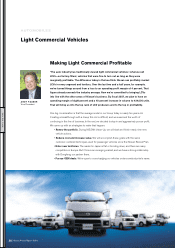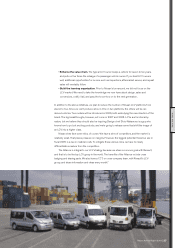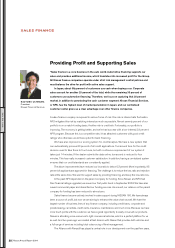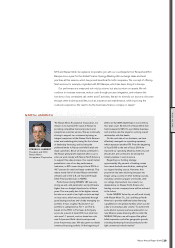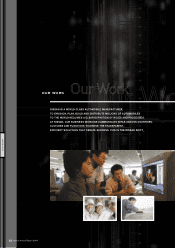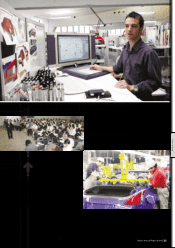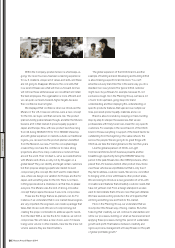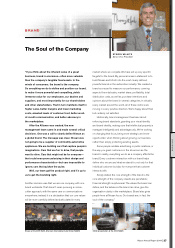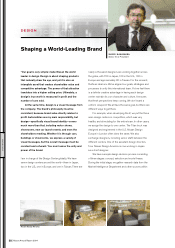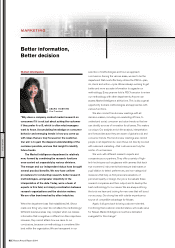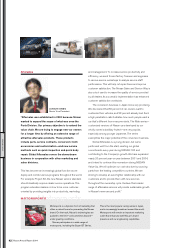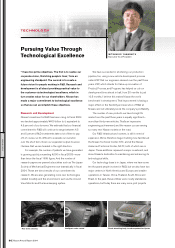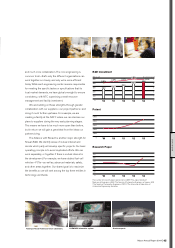Nissan 2005 Annual Report Download - page 38
Download and view the complete annual report
Please find page 38 of the 2005 Nissan annual report below. You can navigate through the pages in the report by either clicking on the pages listed below, or by using the keyword search tool below to find specific information within the annual report.
Nissan Annual Report 2004
36
OUR WORK
Within the Company, positive tension is what keeps us
going. Our recent success has been a learning experience
for us. It created a unique set of values and skills, and these
are not going to disappear. Moreover, the core skills that
now exist in Nissan are what will drive us forward. And we
will not lose these skills because we now attract and retain
the best employees. The organization is more efficient, and
we can push our teams towards higher targets because
their confidence level is higher.
We displayed that confidence when we introduced the
Murano in the U.S. Crossover vehicles were a new concept
for the U.S. car buyer, and that carried a risk. The product
planners boldly pushed ahead, though, and after the Murano
became a hit in that market, it proved equally popular in
Japan and Europe. Now, with new product launches rising
from 44 during NISSAN 180 to 70 in NISSAN Value-Up,
and with global expansion in markets outside our traditional
regions, you can see how the product planners benefited
from the Murano’s success. From the conceptual stage
onward, they now have the confidence to make strong
projections about how many customers a model will have
around the world. Their mindset is, we’ve succeeded before
with Murano and others, so why not try this again on a
global basis? They can identify and target certain customers
but then propose skipping a particular market to avoid
compromising the concept. We don’t want to make bland
cars, where we design one variation for Europe, another for
Japan, and something else for the US. There is no flavor,
nothing special, about a chameleon car that tries to please
everyone. The Murano was the kind of strong, innovative
concept that prospered because it was not a compromise.
These are the things that we as planners can do. For
instance, if we understand that in one market diesel engines
are very important, the engineers can create a package that
takes that into account. We are not compromising, but
creating the proper combination to address specific needs
from the start. With a car like the Z, for instance, we will not
compromise. We will make a clear choice, even if it means
losing some volume in other markets. Cars like the Z are not
volume seekers; they are brand builders.
The global expansion of the Infiniti brand is another
example of building a brand. Developing and building Infiniti
is about making a specific brand decision. You can’t
advertise a luxury brand like this in the same way you do a
standard non-luxury brand. The typical Infiniti customer
might never buy a Nissan, for example, because it’s not
exclusive enough. So in the Planning Group, we have a lot
of work to do upstream, going deep into brand
understanding and then deploying this understanding on
specific products, features that span across multiple car
lines, perceived product quality, materials and so on.
Brand is about consistency; keeping on track, building
step-by-step to sharpen the awareness that we are
professionals with finely tuned cars meant for very specific
customers. For example, in the recent launch of the Infiniti
brand in Korea, everything in support of the brand had to be
outstanding from the beginning—the sales network, the
service, the people. We are going to do great things with
Infiniti as we take the brand global over the next five years.
Like the global expansion of Infiniti, our Light
Commercial Vehicles (LCV) business presents another
breakthrough opportunity during the NISSAN Value-Up
period. In the past, Nissan, like other OEM producers, often
placed the LCV business behind other product lines. Some
view these vehicles as unprofitable, but that is only true if
they fail to address customer needs. We are now committed
to bringing LCVs in-line with Nissan’s other product areas.
We are looking to introduce a new generation of LCVs, with
innovations and features that will satisfy customer needs that
have not yet been met. From a design standpoint, we also
want to demonstrate that LCVs are more than just utilitarian.
We have several exciting products in the LCV pipeline that
will bring something new and fresh to this market.
Here in the Planning Group, we understand that we
must protect the Nissan way of being creative. But while
fostering that creativity, we will continue to standardize and
refine our processes, building on what we have learned and
applying these processes during this period of sustainable
growth and profit. That balance between creativity and
rigorous process management will keep Nissan on the path
of global profitable growth.”


